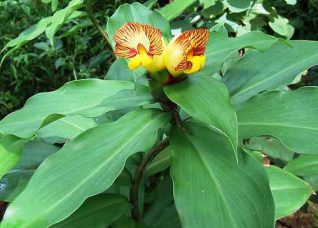
MinerAlert

MinerAlert
Costus pictus [Syn. Costus mexicanus]
Costaceae (˜Zingiberaceae)
Insulin plant, Insulin flower, Painted spiral ginger, Sour ginger, Spiral flag, Spotted spiral ginger, Steladder, Stepladder plant, Huilamole, Pahtsab,Ye totzi (Quattrocchi, 2000; 2012; Erhardt et al., 2002; White, 2002; Sánchez-Monge, 2001).
Apagafuego, Camote de lipana, Camote de ipana, Caña de Cristo, Caña agria, Caña de jabalí, Caña de tigre, Caña de venado Cañuela, Chula laga, Hierba del jabalí, Tirabuzón (Quattrocchi, 2000; 2012; Adame and Adame, 2000; Mendoza-Castelán and Lugo-Pérez, 2011; White, 2002; Sánchez-Monge, 2001; Martínez, 1994).

This rhizomatous herb is native to tropical Mexico; Central America; western South America (Colombia, Ecuador, and Peru), as well as in the Caribbean region. It is also cultivated in India (Quattrocchi, 2000, 2012; Mabberley, 2008; Johnson, 1999; Morton, 1981; Liogier, 1990; Nunez-Melendez, 1981).
The leaves, flowers, rhizomes (underground stems), and tubers (Mendoza-Castelán and Lugo-Pérez, 2011; Berdonces, 2009; Mabberley, 2008; Sánchez-Monge, 2001; Adame and Adame, 2000; Martínez, 1989; Morton, 1981; Liogier, 1974).
The roots, leaves, flowers, and rhizomes can be decocted in water and taken as tea. The crude drug (whole tubers) are sold in certain marketplaces in Mexico.
The main uses for this plant in Mexican traditional medicine are to treat diabetes, urinary problems, venereal disease (gonorrhea), as a diuretic, and to treat kidney cancer (Adame and Adame, 2000; Johnson, 1999; Martínez, 1989; Morton, 1981). The young stems are edible (Berdonces, 2009).Various species belonging to the genus Costus are used for food, paper or medicine throughout the American, Asian, and African tropics (Berdonces, 2009; Sánchez-Monge, 2001; Morton, 1981; Burkill, 1966).
The species C. spicatus is native to the American tropics and commonly known as spiked alpinia, spiked spiral flag, Indian head ginger, and sour cane. In Spanish and Portuguese, the plant is commonly known as caña de Cristo, caña agria, caña de jabalí, caña de puerco, caña de venado, costo de Arabia, canna de macaco, and canna do brejo (Wieresma and León, 2013; White, 2002; Sánchez-Monge, 2001; Schoenhals, 1988).
In Puerto Rico and the Caribbean, the leaves are decocted in water to make a tea to treat flatulence and rheumatism. A tea made from the rhizomes and roots is taken to treat urinary problems, kidney stones, nephritis (kidney inflammation), inflammation of the urethra, as a diaphoretic (to promote sweating), as a diuretic, and as an emmenagogue (to promote menstruation). The acidic juice from the young rhizomes (stems) is taken to treat diabetes, bronchitis, headaches, colds, and fever. The roots are decocted in water to make a tea to treat gastritis, liver problems, and snakebite. The juice from the flowers is taken against internal parasites and for the treatment of vaginal infections (Berdonces, 2009; Liogier, 1990, 1974; Morton, 1981; Nuñez-Meléndez, 1981).
Safety/Precautions:
Before you decide to take any medicinal herb or herbal supplement, be sure to consult with your health care professional first. Avoid self-diagnosis and self-medication: Always be on the safe side!